
|
Ora et Labora
Prayer and Work |
|||||
Stanley Roseman drawing Trappist monks in choir
St. Sixtus Abbey, Belgium, 1981.
St. Sixtus Abbey, Belgium, 1981.
Stanley Roseman
The MONASTIC LIFE
The MONASTIC LIFE
© Stanley Roseman and Ronald Davis - All Rights Reserved
Visual imagery and website content may not be reproduced in any form whatsoever.
Visual imagery and website content may not be reproduced in any form whatsoever.
Daily Life in the Monastery
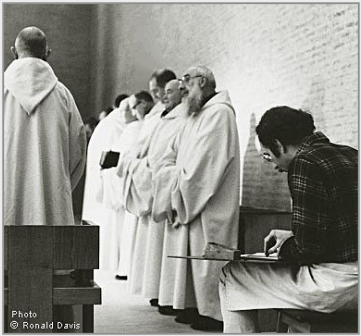
The monastic life is centered on prayer in observing the call to prayer in the Book of Psalms: "At midnight I rise to praise you, O Lord'' and "Seven times a day I praise you.''[1] Monastic leaders such as St. Basil, in the fourth century; John Cassian, in the fifth century; and St. Benedict, in the sixth century, instructed that prayer be complemented by work. Thus was formulated the monastic precept ora et labora, prayer and work.
Sharing in the Daily Life in the Monastery
2. Stanley Roseman drawing Brother Michael, the tailor,
in his workroom at Mount Melleray Abbey, Ireland, 1983.
in his workroom at Mount Melleray Abbey, Ireland, 1983.
Roseman was invited to share in the day-to-day life in monasteries of the Benedictine, Cistercian, Trappist, and Carthusian Orders, the four monastic orders of the Western Church. In over sixty-five monasteries in the British Isles and Continental Europe, the artist created a monumental oeuvre of paintings and drawings. This unprecedented and ecumenical work, which The Los Angeles Times commends as "a sweeping artistic project,'' includes communities of monks and nuns of the Roman Catholic, Anglican, and Lutheran faiths.
Roseman drew monks and nuns chanting the Psalms at the Divine Office and praying and meditating in chapel and in their cells. The artist drew in workplaces, as in the tailor shop, carpentry shop, bookbindery, and on the farm, in the garden, and in the kitchen.
A major part of Roseman's work in monasteries is expressed in the medium of drawing, the foundation of the visual arts. Giorgio Vasari (1511-1574), celebrated Florentine architect, painter, and author of Lives of the Artists, affirms that drawing (disegno) is ''the parent of our three arts, Architecture, Sculpture, and Painting, having its origin in the intellect.''[2]
The Rule of St. Benedict, the basis of monastic observance in the Western Church, is a document consisting of a Prologue and seventy-three short chapters that give spiritual counsel and regulations for daily life in the monastery.
The respected art journal ARA arte religioso actual, Madrid, published a reportage entitled "Stanley Roseman y la Vida Monastica'' and states:
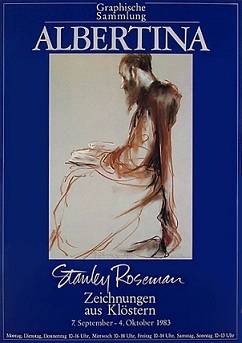
"The pictures - splendid and telling all at once -
form the stimulating vanguard towards
so original and deep a study of the monastic life.''
form the stimulating vanguard towards
so original and deep a study of the monastic life.''
- ARA arte religioso actual, Madrid
3. The Albertina poster for the exhibition
Stanley Roseman - Zeichnungen aus Klöstern, 1983.
Stanley Roseman - Zeichnungen aus Klöstern, 1983.
The superb drawing of the librarian Brother Thijs, a Biblical scholar who kindly assisted the artist with his research on monasticism, was featured on the poster, (fig. 3), for the Albertina's first one-man exhibition of drawings by an American artist. (See the website page "Exhibition at the Albertina.")
"The Therapeutae, Jewish eremites contemporary with the Qumran community, are the subject of Philo of Alexandria's treatise The Contemplative Life. The Therapeutae, whose main settlement was near Alexandria, lived in solitude in hermitages and observed a regime of prayer and reading and studying the Holy Scriptures. On the Sabbath, the hermits met in a sanctuary for a sermon given by an elder. Every seven weeks, as seven was regarded as a sacred number, the hermits assembled for a discourse and common meal followed by a vigil with prayers and singing until dawn.[5]
"The Lives of the Desert Fathers (Historia Monachorum in Aegypto), a fourth-century contemporary account of Christian monks and hermits living in the Egyptian desert, records the vigils kept by those pious men.[6]
"The Rule of St. Benedict allocates five chapters to the Night Office: Chapters 8 and 9, on the Divine Office at night and the number of Psalms for the Night Office; Chapter 10, on Vigils in summer; Chapter 11, on Vigils on Sundays; and Chapter 14, the Psalms for the Night Office for the feasts of the saints.''
A gift copy of the Book of Psalms given in friendship from the monks of the Abbey of La Trappe to Stanley Roseman, of the Jewish faith; and Ronald Davis, of the Roman Catholic faith.
4. Title page of the Book of Psalms.
"For Stanley and Ronald,
De la bibliothèque
Amitiés des moines de La Trappe."
De la bibliothèque
Amitiés des moines de La Trappe."
"The desert settlement of Qumran, near the Dead Sea, was a center of monastic life in Judaism from the second century BC to the first century AD. The Dead Sea Scrolls include the Rule of the Community and accompanying texts that relate the communal life at Qumran: adherence to obedience, celibacy, and self-denial, the solemn ritual of the common meal taken in silence, the daily round of worship with the singing of the Psalms, and the lengthy vigil in the night.[4]
The librarian Frère Benoît, who kindly assisted the artist and his colleague in their research and study, inscribed the Psalter on behalf of the monks:
Vigils at the Chartreuse de la Valsainte in the Swiss Alps
Vigils, or the Night Office, is the first and longest of the canonical hours, called the Divine Office, around which the monastic day is structured. Gathering in choir in the early hours of morning, the monastic community begins Vigils with words from Psalm 51: "Lord open my lips and my mouth will proclaim your praise.''[3]
Roseman drew at Vigils in Benedictine, Cistercian, Trappist, and Carthusian monasteries. The artist recounts: "In my reading and study on the monastic life, I learned that the Night Office observed in monasteries today has an ancient precedent in Judeo-Christian early monastic traditions in the Middle East.
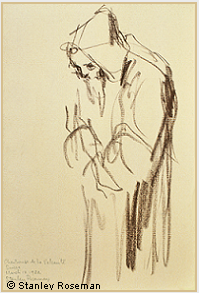
Roseman drew at Vigils when the hermit monks gathered in choir to chant the Psalms, read from the Holy Scriptures, and pray in silence during the long Night Office of two and a half to three hours. Presented here is A Carthusian Monk at Vigils, 1982, (fig. 5), conserved in the Musée Ingres, Montauban. The renowned collection grew from a bequest by Jean-Auguste-Dominique Ingres (1780-1867), whose well-quoted maxim asserts: "Drawing is the integrity of art.''
The deeply felt drawing of the Carthusian monk Brother Louis at Vigils is rendered in bistre chalk on beige paper, which suggests the color of the Carthusian habit of undyed wool. Gradations of the single chalk range from fine description of the hermit's face and beard to bold strokes that describe shadows from the fall of light on the hood, shoulder and arm, and under the sleeve of the habit. With an economy of line, Roseman has created a drawing of spiritual intensity in the depiction of the hermit monk in prayer in the night.
In a cordial letter to Stanley Roseman, Pierre Barousse, distinguished curator of the Musée Ingres, praises A Carthusian Monk at Vigils as a "very beautiful drawing" and writes: "I am, for what is meaningful to me, very sensitive to the purity and the profound interiority expressed in this work of art.''
The Ashmolean Museum, Oxford University, conserves the drawing of Brother Louis A Carthusian Monk Asleep in his Cell, 1982. (See "Benedictines, Cistercians, Trappists, and Carthusians," Page 5 - "Carthusians.")
The Carthusian Order provides for the solitary life of the hermit within the context of a monastic community. The Chartreuse de la Valsainte was founded in 1295 in a secluded valley in the Gruyères range of the Swiss Alps. In the winter of 1982 Roseman and Davis received a cordial letter of invitation from the Prior Dom Augustin Tönz, who writes: "We thank you heartily for your interest in monastic life. . . . Looking forward to receiving you here. . . We pray with you for the Lord's choice blessings for yourselves and your work.''
1. Psalm 119, In praise of the divine Law. The Psalter is comprised of one hundred and fifty Psalms. Psalms 10 to 148 in the Hebrew Bible
are one number ahead of the Greek Septuagint and Latin Vulgate Bibles. The Greek and the Vulgate combine Psalms 9 and 10 as well as
Psalms 114 and 115 while separating into two parts each Psalm 116 and Psalm 148. The Rule of St. Benedict uses the numbering
of the Psalms in the Vulgate Bible.
2. Giorgio Vasari , Vasari on Technique, (New York: Dover Publications, Inc.), p. 205.
3. Psalm 51 in the Hebrew Bible is numbered Psalm 50 in the Vulgate.
4. Geza Vermes, The Complete Dead Sea Scrolls in English, (Harmondsworth, England: Penguin Books, 1962), The Community Rule, pp. 97-123.
5. Philo of Alexandria, The Contemplative Life and selected writings, translation by David Winston, (Paulist Press, New York, 1981), pp. 41-57.
6. The Lives of the Desert Fathers, translated by Norman Russell, (Oxford: Mowbray, and Michigan: Cistercian Studies, 1980), pp. (111, 112, 134).
7. The Rule of the Master, translated by Luke Eberle, O.S.B., (Michigan: Cistercian Publications, 1977), pp. 208, 209.
8. P. Reginald, Stift Melk, (Munich: Verlag Schnell, 1968) pp. 1,2.
9. Ibid., p. 10.
10.Stanley Roseman - Dessins sur la Danse à l'Opéra de Paris (text in French and English), Bibliothèque Nationale de France, 1996, p. 12.
are one number ahead of the Greek Septuagint and Latin Vulgate Bibles. The Greek and the Vulgate combine Psalms 9 and 10 as well as
Psalms 114 and 115 while separating into two parts each Psalm 116 and Psalm 148. The Rule of St. Benedict uses the numbering
of the Psalms in the Vulgate Bible.
2. Giorgio Vasari , Vasari on Technique, (New York: Dover Publications, Inc.), p. 205.
3. Psalm 51 in the Hebrew Bible is numbered Psalm 50 in the Vulgate.
4. Geza Vermes, The Complete Dead Sea Scrolls in English, (Harmondsworth, England: Penguin Books, 1962), The Community Rule, pp. 97-123.
5. Philo of Alexandria, The Contemplative Life and selected writings, translation by David Winston, (Paulist Press, New York, 1981), pp. 41-57.
6. The Lives of the Desert Fathers, translated by Norman Russell, (Oxford: Mowbray, and Michigan: Cistercian Studies, 1980), pp. (111, 112, 134).
7. The Rule of the Master, translated by Luke Eberle, O.S.B., (Michigan: Cistercian Publications, 1977), pp. 208, 209.
8. P. Reginald, Stift Melk, (Munich: Verlag Schnell, 1968) pp. 1,2.
9. Ibid., p. 10.
10.Stanley Roseman - Dessins sur la Danse à l'Opéra de Paris (text in French and English), Bibliothèque Nationale de France, 1996, p. 12.
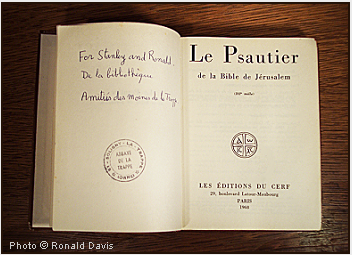
Lectio Divina - St. Adelbert Abbey, a Benedictine Monastery in North Holland
The Rule of St. Benedict assigns great importance to lectio divina, sacred reading, and allocates a significant portion of time in the monastic schedule for reading and study. Presented below, (fig. 6), is the beautiful drawing Father Adelbert absorbed in Reading, 1978. The Dutch Benedictine monk is named after the eighth-century patron saint of St. Adelbert Abbey, located near the seacoast in North Holland.
Roseman drew Father Adelbert in the library, where the artist was invited to do his own research and study. The artist writes in a text to accompany his drawings and paintings that "St. Benedict follows the earlier, sixth-century Rule of the Master that prescribes as essential to the contemplative life both manual work and sacred reading in the intervals between the hours of the Divine Office.[7]
Father Adelbert, having retired from the administrative post of novice master, had considerably more time for spiritual reading and kindly sat for the artist. In a clear, northern light entering the library, Roseman drew in chalks with strong chiaroscuro modeling to depict the Benedictine monk seated at the reading table.
The monk's black habit establishes the pyramidal composition; gray paper imparts a cool, atmospheric tonality to the drawing. White highlights illuminate the figure leaning over the table. The viewer's attention is engaged by the open book; the monk's left hand resting on a line of text; and the face of the Benedictine monk, whose eyes under bushy white eyebrows are intently fixed on a page of the book.
6. Father Adelbert absorbed in Reading, 1978
St. Adelbert Abbey, the Netherlands
Chalks on paper, 33 x 48 cm
Private collection, the Netherlands
St. Adelbert Abbey, the Netherlands
Chalks on paper, 33 x 48 cm
Private collection, the Netherlands
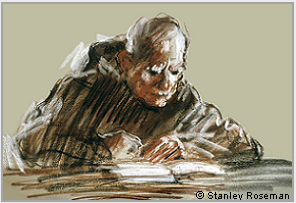
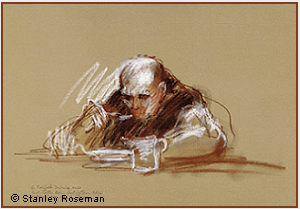
In the Refectory at the Trappist Abbey of St. Sixtus in Flanders
In 1978, the first year of Roseman's work on the monastic life, the artist and his colleague were cordially invited to the Trappist Abbey of St. Sixtus, founded in 1831 in the farming countryside of Western Flanders.
From the collection of the Musée des Beaux-Arts, Bordeaux, is the impressive drawing A Trappist Monk at Dinner, 1978, (fig. 8).
Roseman recounts in his journal: "With the hearty welcome from Abbot Remi, Brother Bertrand, and the Community, I enthusiastically took up my paper and chalks again to continue my work on the monastic life.'' The artist's drawings from sojourns at St. Sixtus Abbey over the years include A Visiting Benedictine in a Trappist Choir, 1978, collection of the Albertina; and Portrait of Brother Jos, 1981, Musée des Beaux-Arts, Rouen. (See website pages "On the Continent to Belgium, the Netherlands, and Germany,'' and "Exhibition at the Albertina.'')
Mother Geneviève-Marie, Abbess of Echourgnac Abbey, in Aquitaine, cordially invited Roseman and Davis to the monastery in 1998. The Abbess was very appreciative of Roseman's interest in the monastic life and thoughtfully invited the artist to draw the nuns at the communal prayer in choir and at work.
Roseman drew the figure in movement with fluent strokes of bistre and black chalks complemented by fine rendering of the nun's face as she concentrates on her task. With the combination of chalks and reserved areas of the gray paper, the artist depicts light and shade on the figure. Slightly stooped, the elderly nun wears an apron and head covering that the nuns of Echourgnac wear in the fromagerie, or cheese dairy.
7. A Trappist Nun Carrying a Tray
of Cheeses in the Fromagerie, 1998
Abbaye d'Echourgnac, France
Chalks on paper, 50 x 35 cm
Private collection, France
of Cheeses in the Fromagerie, 1998
Abbaye d'Echourgnac, France
Chalks on paper, 50 x 35 cm
Private collection, France
Work in the Fromagerie at the Trappist Convent of Echourgnac in Aquitaine
The Bibliothèque Nationale de France in a biographical essay on the artist commends Roseman for his "profound interest in the human condition in portraying different kinds of people, professions, social or artistic groups." Exemplary of this statement is the poignant drawing seen here of a woman of advancing years who continues to work in the monastery and to contribute to the life of the community.
8. A Trappist Monk at Dinner, 1978
St. Sixtus Abbey, Belgium
Chalks on paper, 33 x 48 cm
Musée des Beaux-Arts, Bordeaux
St. Sixtus Abbey, Belgium
Chalks on paper, 33 x 48 cm
Musée des Beaux-Arts, Bordeaux
The monastic meal is observed with solemnity and taken in silence while a member of the Community reads aloud from an edifying book. In the present work, the pyramidal composition places the figure of Brother Pacific in the center of the page. Strong contrasts of black and white chalks depict the monk's black scapular and white tunic. The ochre paper imparts a warm tonality to the composition.
The artist effectively uses white chalk to describe forms, as with the bowl and pitcher in the foreground and the monk's right hand holding a spoon; to render highlights on the elderly monk's forehead, cranium, and sleeves of his tunic; and to indicate spatial dimension. Roseman has created a striking, pictorial image of a Trappist monk at dinner.
''The drawings, for the most part done in combinations of black, white, and sepia chalk on beige or gray paper, are impressive. Roseman has captured the personalities of many individual monks while often managing to depict their lifestyles as well. . . . The artist's gray, brown, dark and light tones vary as subtly and surely as the monks who live out their discipline of prayer and work and meals in common.''
- The Boston Globe
9. Brother Jonas
in the Calefactory, 1978
Abbey of Melk, Austria
Chalks on paper, 33 x 48 cm
Los Angeles County Museum of Art
in the Calefactory, 1978
Abbey of Melk, Austria
Chalks on paper, 33 x 48 cm
Los Angeles County Museum of Art
Leopold III founded several religious houses, relocated the royal residence near Vienna, and gave Melk and its properties to the monks. Over the following centuries, the Abbey flourished as a spiritual center as well as a center of learning, with the administration of a monastery school in the Benedictine tradition. Melk houses an important library containing some 80,000 volumes, 2,000 illuminated manuscripts, and 750 incunabula.[9]
The Rule of St. Benedict, Chapter 48 "The Daily Manual Labor'' instructs that work is an essential part of a life centered on prayer. Roseman drew members of monastic communities at different kinds of manual work and domestic chores. As well as drawing in those places of work mentioned above, the artist also drew in the fromagerie, as cheese production is a traditional work in Cistercian and Trappist monasteries in France.
The Trappist nuns of Echourgnac Abbey continue the tradition of cheese production with the fabrication of excellent quality cheeses, a main source of income for the monastery. Presented here is the beautiful drawing A Trappist Nun carrying a Tray of Cheeses in the Fromagerie, (fig. 7).
In the Calefactory at the Benedictine Abbey of Melk overlooking the Danube
Roseman and Davis were welcomed by Abbot Burkhard Ellegast at Melk in the autumn of 1978. The Abbot introduced them to Brother Jonas, who gave them a tour of the monastery. The artist drew the blond-haired, bearded monk at prayer in choir and at study in his cell. The artist also drew Brother Jonas in the calefactory, (fig. 9, below), where they had coffee together after dinner and enjoyed convivial conversations about music, art, and architecture. The calefactory in medieval monasteries was one of the only rooms with a fireplace and was used as a sitting room by the community.
The Los Angeles County Museum of Art conserves the excellent drawing Brother Jonas in the Calefactory, 1978, presented below, (fig. 9).
The majestic Benedictine Abbey of Melk, a splendid example of Baroque architecture, stands on a high plateau overlooking the Danube. The history of the monastery dates from 1089 when the Margrave Leopold II of Austria invited a community of Benedictine monks to reside in his ancestral castle of the Babenbergs at Melk. The ruler's heir Leopold III, born at Melk in 1075, is venerated as Patron Saint of Austria and the monastery.[8]
"I learned that Beethoven's teacher the respected musicologist and composer J. G. Albrechtsberger was educated at Melk and later appointed organist at the Abbey and chapel-master of St. Stephen's Cathedral in Vienna. Mozart performed in the monastery's elegant reception room called the Marble Hall. In c.1949 a copy of Haydn's score Violin Concerto in A Major was discovered in the extensive music archives of the Abbey library. The composition has since become known as the 'Melk Concerto.' "
The Musée d'Art et d'Histoire, Geneva, conserves a portrait of Brother Jonas. The drawing is presented on the website page "The Monastic Life" - Page 4 - "Across the Continent to Austria, Hungary, and Poland."
Roseman recounts: "Jonas and I shared a great interest in music. It seemed especially appropriate to be sharing such an interest with him at Melk, where music has long held an important place in the life of the monastery.
Brother Jonas' striking appearance in the drawing reminds one of representations of St. Leopold of Austria in illuminated manuscripts, stained-glass windows, and Renaissance paintings in which the patron saint is often depicted with blond, shoulder-length hair and full beard.
In the Roseman drawing vigorous strokes of black chalk describing the Benedictine habit form a bold abstraction, complemented by detail rendering of the monk's face, hair, beard, and right hand. Black, bistre, and red chalks are augmented with white chalk adding highlights on the figure and indicating spacial dimension. Beige paper imparts a blond tonality to the composition and gives a warm sheen to the black habit.
The husky, Benedictine monk is seated on a couch in the calefactory. His right arm rests on the back of the couch, and holding a cigarette, his hand falls in a relaxed manner by his side. Roseman has drawn an engaging image of a young monk taking a few minutes of relaxation in the regimented daily routine of monastic life.
Roseman's drawings of monks at times of relaxation, as with Brother Jonas in the Calefactory, include Father Gregory at Tea, 1980, St. Augustine's Abbey, England, (Musée des-Beaux-Arts, Rouen); and also from St. Augustine's, a drawing of the elderly, bespectacled Father Paulinus smoking his pipe at tea in the common room, (Private collection, Michigan). At Tyniec Abbey in Poland, Roseman drew Brother Florian playing the Recorder, 1978, (Private collection, Switzerland).
"Stanley Roseman's drawings show the many facets of his great talents as a draughtsman.''[10]
- Bibliothèque Nationale de France
In the Library at the Trappist Abbey of Sion in the Netherlands
In recounting his sojourn at Sion Abbey, Roseman writes:
"I asked the Abbot if I may include a portrait of him in my work on the monastic life. Abbot Adolfus told me that he was also the librarian and kindly invited me to join him at his desk in the library, where he worked and studied as well as where he did his spiritual reading.
"The library at Sion Abbey was a modest-sized room that seemed filled to capacity with books. I was very pleased to be drawing in the library, for with my love of books, I often sought monastery libraries in which to draw as well as for reading and study. I sat near the Abbot, whose desk was placed by a window which brought a clear, morning light into the room and illuminated the face of the ascetic Dutchman absorbed in his reading."
Presented here is Portrait of the Abbot of Sion. Roseman drew the Abbot in profile, head inclined and eyes lowered. Chalks of earth pigments imbue the drawing with a warm tonality. Black chalk delineates the fringe of hair, complemented by white highlights on the monk's face and cranium. Roseman has drawn a deeply felt portrait of a man dedicated to the contemplative life.
The Curator of Prints and Drawings of the Israel Museum, Meira Perry-Lehmann, writes in her cordial letter of April 1986 acknowledging receipt of the Portrait of the Abbot of Sion:
"I am very pleased to let you know that the drawing by Stanley Roseman
has arrived safely and is now in our department.
It is indeed a fine work and a welcome addition to our collection."
has arrived safely and is now in our department.
It is indeed a fine work and a welcome addition to our collection."
- Meira Perry-Lehmann
Curator of Prints and Drawings
The Israel Museum, Jerusalem
Curator of Prints and Drawings
The Israel Museum, Jerusalem
10. Portrait of the Abbot of Sion
1984, Sion Abbey
The Netherlands
Chalks on paper, 50 x 35 cm
The Israel Museum, Jerusalem
1984, Sion Abbey
The Netherlands
Chalks on paper, 50 x 35 cm
The Israel Museum, Jerusalem
The Israel Museum, Jerusalem, conserves the fine drawing Portrait of the Abbot of Sion from Roseman's return to the Netherlands in 1984, (fig. 10, below). Portraiture holds an important place in the artist's oeuvre on the monastic life. Aftonbladet, Stockholm, the leading Swedish daily, commends Roseman for creating portraits "artistically on a high level as well as accurately expressive of the human dimension.''
"At midnight I rise to praise you, O Lord'' - Psalm 119:62
5. A Carthusian Monk
at Vigils, 1982
Chartreuse de la Valsainte, Switzerland
Bistre chalk on paper, 50 x 35 cm
Musée Ingres, Montauban
at Vigils, 1982
Chartreuse de la Valsainte, Switzerland
Bistre chalk on paper, 50 x 35 cm
Musée Ingres, Montauban
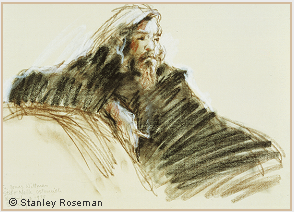
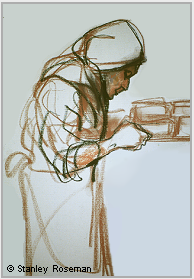
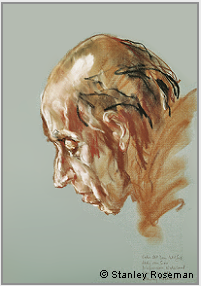
Vespers at Casa Emmaus in Tuscany
Presented here is the beautiful portrait drawing Sister Paola at Vespers, (fig. 11). With a harmony of fluent lines describing the veil and fine chiaroscuro modeling of the face of the Benedictine nun, Roseman eloquently conveys the inner calm of a middle-aged woman devoted to the contemplative life.
12. Frère Samuel at Compline, 2002
Abbaye de la Trappe, France
Chalks on paper, 50 x 35 cm
Private collection, France
Abbaye de la Trappe, France
Chalks on paper, 50 x 35 cm
Private collection, France
"I will say of the Lord, 'He is my refuge and my fortress:
my God; in him I will trust.' "
my God; in him I will trust.' "
- from Psalm 91, sung at Compline
Compline at the Abbey of La Trappe in Normandy
"Seven times a day I praise you" - Psalm 119:164
Sion Abbey is a Dutch Trappist monastery founded in 1833 in Diepenveen, in the eastern province of Overijssel. Abbot Adolfus van der Zeijden was introduced to Roseman's work by Abbot Gerard Mathijsen, Abbot of St. Adelbert. Abbot Gerard, a long-time friend of the artist and his colleague, had graciously received them on a number of sojourns at the monastery over the years.
Abbot Adolfus cordially invited Roseman and Davis to Sion Abbey and welcomed them warmly. Greatly encouraging to the artist, the Abbot told Roseman that his work brings an awareness of contemplative life in the modern age and fosters understanding and ecumenicism between people of the Jewish and Christian faiths.
The nuns of Casa Emmaus, in Tuscany, are members of the Camaldolese Congregation of the Order of St. Benedict, which evolved from the ascetic ideals of the eleventh-century reformer St. Romuald, founder of the Hermitage and Monastery of Camaldoli in the Apennines. Roseman began the second year of his work on the monastic life at Camaldoli in January of 1979, and he and Davis returned to Camaldoli in the summer of 1998. That summer, the Prioress Mother Domenica cordially invited them to Casa Emmaus.
When the monastery bell tolled for the Divine Office, Roseman accompanied the community to draw at the Night Office and at the daytime offices of Lauds and Prime in the early morning, Terce at mid-morning, Sext at midday, None in the early afternoon, Vespers in the early evening, and Compline at the close of the day.
Roseman drew at communal meals in the refectory and at afternoon tea or coffee in the calefactory. The artist drew individuals writing in the scriptorium and reading and studying in the library.
At St. Adelbert Abbey, in the Netherlands, the artist drew Brother Thijs in the Library, 1982, acquired by the Graphische Sammlung Albertina, Vienna, which houses a renowned collection of master drawings.
"Every day will I bless you;
and I will praise your name forever and ever.''
and I will praise your name forever and ever.''
- from Psalm 145, sung at Vespers
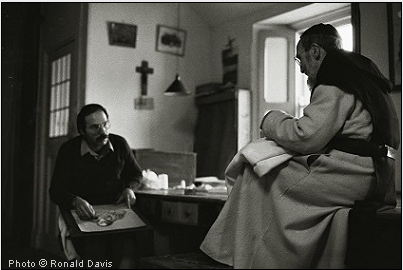
1. Ora et Labora -
Prayer and Work
2. Daily Life in the Monastery
Prayer and Work
2. Daily Life in the Monastery
"For he is the Lord our God:
we are his people and the sheep of his pasture."
we are his people and the sheep of his pasture."
- from Psalm 95, sung at Vigils
11. Sister Paola at Vespers
1998, Casa Emmaus, Italy
Chalks on paper, 50 x 35 cm
Private collection, Switzerland
1998, Casa Emmaus, Italy
Chalks on paper, 50 x 35 cm
Private collection, Switzerland
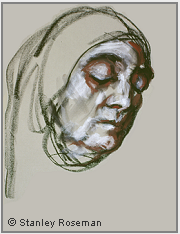
The Abbey of La Trappe, in Normandy, was a center of reform in the Cistercian Order in the seventeenth century. The reform gave rise to the Order of Cistercians of the Strict Observance, also known as the Trappist Order. The warm welcome and gracious hospitality Roseman and Davis received from Abbot Gérard Dubois and the Community in June 1979 was the beginning of a long and creative association with the monastery.
Frère Samuel shared a friendship with the artist and his colleague from their first sojourn at La Trappe. The Trappist monk was then the manager of the Abbey's dairy farm. Farming has been a traditional occupation in Cistercian monasteries since the beginning of the Order in the closing years of the eleventh century. The farm at La Trappe, with over a hundred dairy cows, provided the monastery with its main source of income.
Frère Samuel at Compline, (fig. 12), is an impressive work from Roseman and Davis' return to La Trappe in 2002. With sculptural modeling in a combination of chalks, the artist renders the monk's face with white highlights on the brow, cheeks, and nose; passages of white on the hair and beard; complemented by warm shading in red and bistre chalks. Strong, linear description in black chalk defines Frère Samuel's cowl and hood, which rests on the monk's shoulders as he sits in choir, his head lowered in prayer. Roseman has drawn a deeply moving portrait of a man of advancing years in prayerful communion with God.
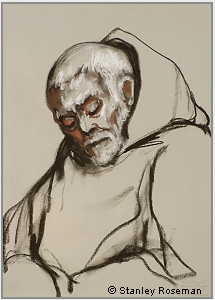
Davis' photographs complement Roseman's drawings and paintings on the monastic life and provide a visual record of the artist at work behind the monastery walls.